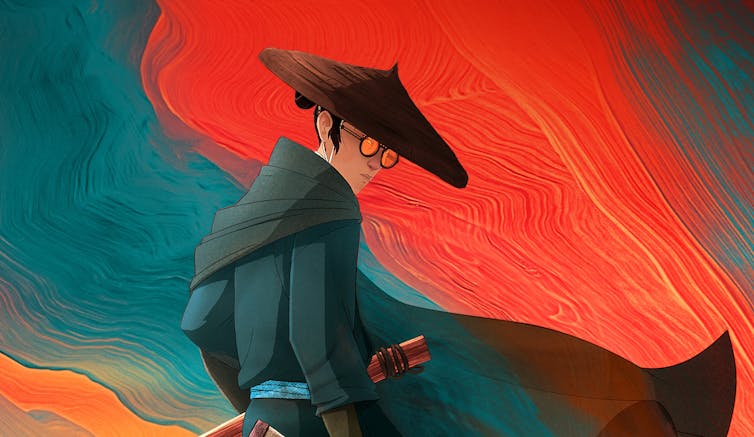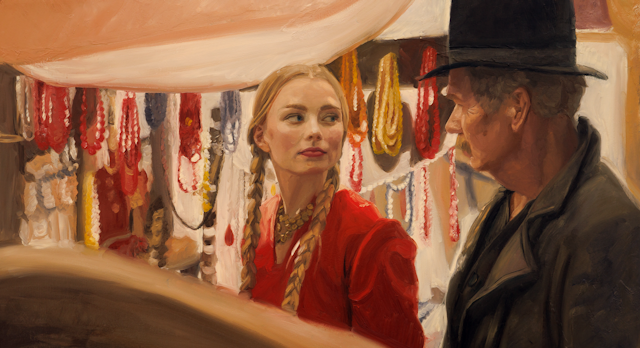The mark of a good film, for me, is the way I feel when it’s over. If I jump up to brush off the popcorn and pull on my coat, it’s forgettable fare. If I’m still glued to my seat as the final credits roll, it will probably stick with me for quite some time.
Such was the case with Loving Vincent in 2017, a beautiful film about the life and death of Vincent van Gogh. The story, about a man attempting to deliver the artist’s final letter and, in the process, unravelling the mystery around his death, wasn’t what hooked me.
It was the stunning look of the film, which made you feel as though you had tumbled headfirst through the frame of one of Van Gogh’s paintings. First filmed in live action, 125 artists then created oil paintings of each frame of the film (62,000 in total) in Van Gogh’s distinctive style.
Now, the film’s creators (husband and wife team Dorota Kobiela-Welchman and Hugh Welchman) have released The Peasants, another oil-painted masterpiece, this time adapting the Nobel-prize winning novel by Polish writer, Władysław Reymont. Our reviewer, an expert in Polish literature and culture, was pleased to find that the film stayed faithful to its source material – while also bringing fresh readings to a novel that is nearly 120 years old.
This time the visuals are inspired by famous Polish and European painters, including Ferdynand Ruszczyc, Jean-François Millet and Józef Chełmoński. Part of the fun is recognising the moments the action mirrors a famous painting, like when the main character, Jagna, turns her head in the perfect image of Vermeer’s Girl with a Pearl Earring. It’s an instant cult classic.
Read more: The Peasants: this oil-painted film of Władysław Reymont's novel is a visual masterpiece
Another cult classic worth watching this weekend is The Wicker Man, which turned 50 on Wednesday. The film has been described as “the Citizen Kane of horror films”, and anyone who has watched it has their own unique relationship to its unnerving story.
The Wicker Man follows a devout Christian police officer (Edward Woodward) as he arrives on a remote island community, in search of a missing girl. As his investigation progresses, it soon becomes clear that the isolated people live by the rules of a thoroughly alternative belief system.
As our writer explains, the film’s director Robin Hardy thought of the film as a game. With clues at every turn to help the audience solve the puzzle, The Wicker Man rewards repeated viewings.
Read more: The Wicker Man at 50: how the strange 1970s British film became a cult classic
A Japanese history
Blue Eye Samurai is the best TV show I’ve watched this year. The Netflix anime series tells the story of a master samurai – a young woman of mixed Japanese and English heritage, living disguised as a boy – as she carves her path to revenge on her white father in Edo-period Japan. The story’s depiction of women and characters with disabilities is refreshing, and the animation stunning.
But I finished the series wondering just how realistic these depictions were, as well as its constant – and increasingly horrifying – displays of violence. This piece from historian of Japan Ruth Starr brilliantly sorts the real history of the show from moments of creative licence.

There’s more Japanese history to be learned at Japan: Myths to Manga, on at London’s Young V&A museum. Aimed at families – but with plenty to offer to solo adult visitors, too – the exhibition promises an atmospheric trip through the ways landscape and folklore have influenced Japan’s culture, technology and design. Our reviewer, a leading expert in Japanese translation, was impressed – particularly by the inclusion of clothes made by the 12-year-old artist Coco Pink, which explore themes of waste reduction.
Read more: Japan: Myths to Manga – Young V&A exhibition celebrates nature's influence on Japanese culture
And the winner is…
I’ve never been much of a gamer. In years gone by, I – wrongly – thought of them as timewasters. But my younger brother, an avid gamer, has taught me to see the high artistry at work in some of his favourite titles.
He plays Xenoblade because each game tells a grand narrative that players can participate in. Fire Emblem: Three Houses feels different each time he plays, with hundreds of character and plot combinations offering hours of enjoyment.
So, I was really interested to read about the six titles nominated for this year’s Game Awards – the industry’s equivalent of the Oscars. And a diverse bunch they are. We asked six experts to review the contenders: Marvel’s Spider-Man 2 was dubbed “balletic”, Super Mario Bros. Wonder “brilliant”, Baldur’s Gate 3 “hugely enjoyable”, Resident Evil 4 “unforgettable”, Alan Wake 2 “haunting”, and Zelda: Tears of the Kingdom “spellbinding”.
The best one? The judges have now declared Baldur’s Gate 3 game of the year 2023.
Read more: All the video games shortlisted for the 2023 Game Awards – reviewed by experts
Read more: Baldurs Gate 3 wins game of the year at 2023's Game Awards – an expert review

Looking for something good? Cut through the noise with a carefully curated selection of the latest releases, live events and exhibitions, straight to your inbox every fortnight, on Fridays. Sign up here.

